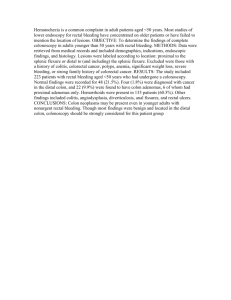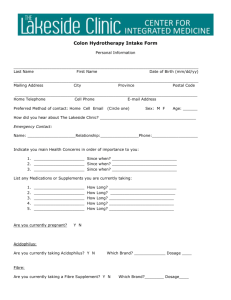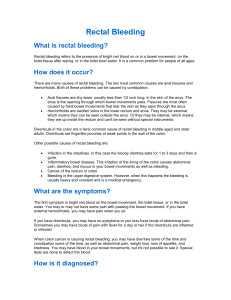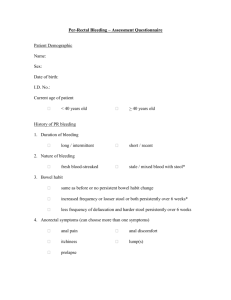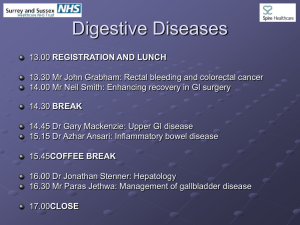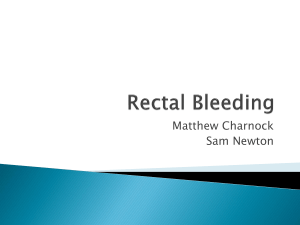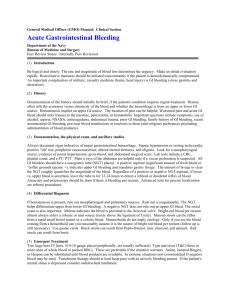Rectal Bleeding
advertisement
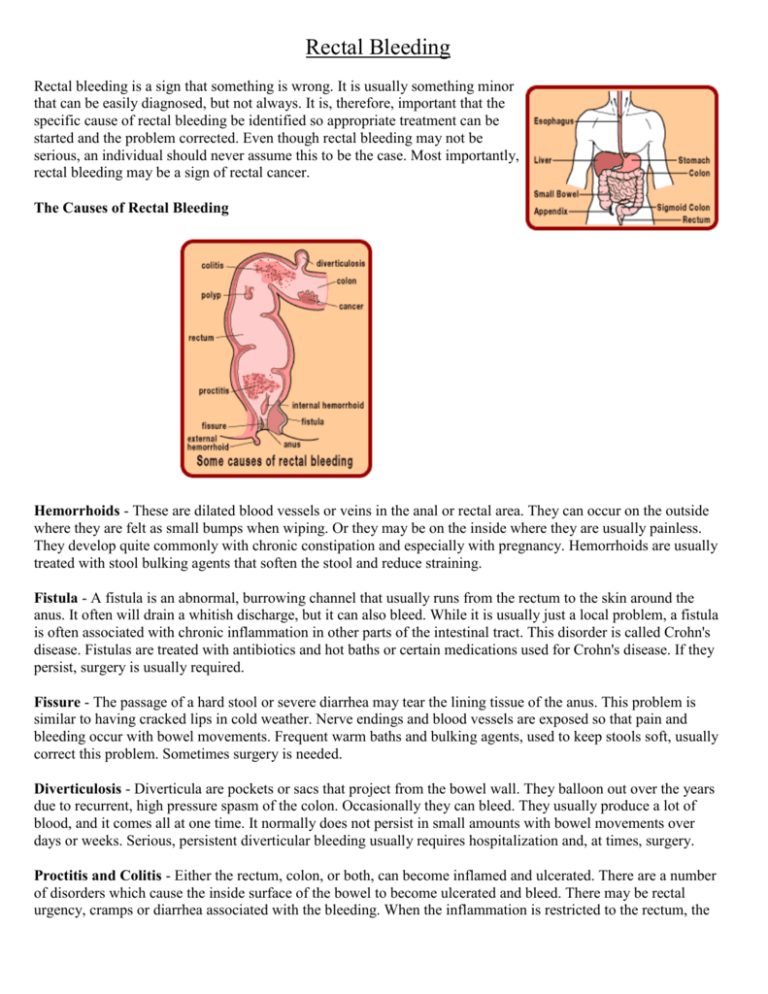
Rectal Bleeding Rectal bleeding is a sign that something is wrong. It is usually something minor that can be easily diagnosed, but not always. It is, therefore, important that the specific cause of rectal bleeding be identified so appropriate treatment can be started and the problem corrected. Even though rectal bleeding may not be serious, an individual should never assume this to be the case. Most importantly, rectal bleeding may be a sign of rectal cancer. The Causes of Rectal Bleeding Hemorrhoids - These are dilated blood vessels or veins in the anal or rectal area. They can occur on the outside where they are felt as small bumps when wiping. Or they may be on the inside where they are usually painless. They develop quite commonly with chronic constipation and especially with pregnancy. Hemorrhoids are usually treated with stool bulking agents that soften the stool and reduce straining. Fistula - A fistula is an abnormal, burrowing channel that usually runs from the rectum to the skin around the anus. It often will drain a whitish discharge, but it can also bleed. While it is usually just a local problem, a fistula is often associated with chronic inflammation in other parts of the intestinal tract. This disorder is called Crohn's disease. Fistulas are treated with antibiotics and hot baths or certain medications used for Crohn's disease. If they persist, surgery is usually required. Fissure - The passage of a hard stool or severe diarrhea may tear the lining tissue of the anus. This problem is similar to having cracked lips in cold weather. Nerve endings and blood vessels are exposed so that pain and bleeding occur with bowel movements. Frequent warm baths and bulking agents, used to keep stools soft, usually correct this problem. Sometimes surgery is needed. Diverticulosis - Diverticula are pockets or sacs that project from the bowel wall. They balloon out over the years due to recurrent, high pressure spasm of the colon. Occasionally they can bleed. They usually produce a lot of blood, and it comes all at one time. It normally does not persist in small amounts with bowel movements over days or weeks. Serious, persistent diverticular bleeding usually requires hospitalization and, at times, surgery. Proctitis and Colitis - Either the rectum, colon, or both, can become inflamed and ulcerated. There are a number of disorders which cause the inside surface of the bowel to become ulcerated and bleed. There may be rectal urgency, cramps or diarrhea associated with the bleeding. When the inflammation is restricted to the rectum, the condition is called proctitis. When the colon is involved, it is called colitis. It is important to identify the specific cause of the inflammation so that appropriate treatment can be started. Polyps and Cancer - Of course, the greatest concern about rectal bleeding is cancer. Polyps are benign growths in the colon. When polyps reach a large size, they can bleed. And certain types of polyps turn into cancer. Colon cancer is usually curable when discovered early. It most often occurs in people over the age of 50, but it is not unheard of in younger individuals, even in their 30's or younger. Because colon cancer is such a common cancer, it is always considered as a possible diagnosis. Protrusion of the Rectum - Some older individuals will have weakened rectal support tissues. Part of the rectum then can project from the anus and bleed. This condition is called rectal prolapse. It can be felt as an abnormal bulging from the rectum when wiping. Surgery is the only effective treatment. The Diagnosis The Medical History - What is the patient's age? Older people tend to have polyps and cancer more often. Is there anal pain and a hard, large stool associated with bleeding? A tear of the anus (fissure) may be the answer. Does blood drip into the toilet after a bowel movement? Bleeding hemorrhoids may be the problem. The color and frequency of the bleeding are additional considerations. In most cases, the medical history provides clues, but never the final answer. The Visual and Digital Exam - The physician will inspect the anal area looking for tears and hemorrhoids. A finger exam can provide information when there is tenderness or a tumor inside. In men, the prostate is also examined. Endoscopy - There are several types of endoscopes used to view the colon. In the office, the physician may use a rigid or, more commonly, a flexible viewing sigmoidoscope. This exam is called flexible sigmoidoscopy and is performed in 5 to 10 minutes. A more thorough exam is accomplished with a colonoscope, allowing the physician to view the entire 5- to 6-foot long colon. Sedation is usually given for this exam. Frequently a bleeding lesion will be present beyond the reach of the sigmoidoscope. So colonoscopy may be the best initial exam. Both exams are usually done on an outpatient basis. Barium Enema X-ray - This is a complementary exam that uses liquid barium inserted by enema into the rectum. X-rays highlight abnormal shadows, such as tumors, diverticuli and colitis. By itself, however, it does not identify an actual bleeding point. Summary Rectal bleeding always means that there is a problem. It is usually not a serious problem, but it should always be assumed to be serious until proven otherwise. The diagnosis is easy to make and effective treatment is almost always available. This packet was prepared for you by Dr. Aaron J. Burrows (303) 320-1111
